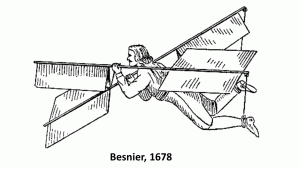In 1678, a French locksmith named Besnier built a remarkable set of flapping wings that actually worked… sort of. As Octave Chanute explains in his brilliant book Progress In Flying Machines, Besnier never claimed he could rise from the ground or even fly horizontally, but was able to accomplish “short downward flights assisted by gravity.”
Sounds suspiciously like a euphemism for “falling” to me, but it was actually a bit more impressive than that. His first experiment involved jumping off a chair, and when the results at that altitude were promising, he progressed to jumping off a table and then out a windowsill. He eventually worked up to leaping from a second story rooftop and soaring over the cottage next door. Not bad! Unlike many other experimenters of his time, there is no record of Besnier ever injuring himself.
The apparatus was clever in its simplicity. The muslin flaps were designed to fold on the upswing, then snap open on the downswing, creating enough lifting force to slow his fall and allow him to glide modest distances. After mastering this maneuver, he sold the wings to a traveling mountebank who performed with them in fairs.
LESSON: When testing an experimental flying machine, avoid injuring yourself by flying at a low altitude. Like, dining-room-chair-seat-level low. And it might be wise to have a cash-out plan that involves selling your wings to a traveling circus performer.
